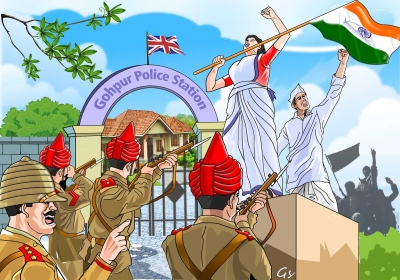
As we celebrate 75 years of independence, here are some unheard stories of our freedom fighters.
Golden girl kanaklata
The 16 years old kanaklata was determined to participate in the hoisting of the flag on Gohpur police station close to her house.
It was a period of turmoil in the country and talk of freedom was in the air. Like many other youngsters of her time, Kanaklata Barua felt a passionate desire to help free her motherland. She had lost her parents, one after the other by the time she was 14 and was brought up by her grandparents.
Call to hoist the tricolour on police stations
On September 18, 1942, a few weeks after the ‘Quit India’ resolution had been passed, a leader from Tejpur, Assam, gave instructions to hoist the tricolour on all police stations and government buildings in the district. The 16-year-old Kanaklata was determined to participate in the hoisting of the flag on Gohpur Police Station close to her house. The people had been asked to gather at a place some distance away from the police station on the morning of September 20. Kanaklata finished her household chores. Then she said to her younger sister, “Let us have breakfast together. God alone knows whether we shall meet again.” Kanaklata led one of the groups that advanced towards the police station shouting slogans like ‘Glory to Mother India’ and ‘Mahatma Gandhi ki Jai’.
The officer in charge of the police station warned them not to advance but Kanaklata pressed forward saying, “Don’t try to stop us! We shall leave only after putting the flag up!”
Felled by police bullets
The police opened fire. Some people from the group turned and fled, but Kanaklata continued to press fonward. The police fired again and Kanaklata was hit in the chest. Others around her were also felled by the bullets but now they were very close to the police station and one member of the group, Ram Pati Rajkhoa snatched the flag from the dying Kanaklata, climbed to the top of the police station and planted the flag there.
Her sister and her grandparents broke down when her comrades brought her body home. But Kanaklata would not have wanted it any other way. If she had had another life to give, she would have perhaps gladly given away that too for her beloved country.
Robin Hood of the Godavari
From the jungles of the Rampa region in the East Godavari district of Andhra Pradesh emerged a young hero who galvanised the local Adivasi tribals to rise against the British Raj in the 1920s. His name was Alluri Sitarama Raju. The Madras Forest Act had severely affected the tribal way of life. It prevented the tribals from engaging in the traditional method of shifting cultivation and collecting forest produce. They ended up being exploited for cheap or free labour by the British.
Raju channelled the tribal discontent into an anti-British force. He realised that mere bows and arrows were not enough. So he conducted lightning strikes on police stations, raiding their arsenal of guns and ammunition. He would announce the date and time of attack and even enter the details of the loot in the station diary!
For two years from 1922-1924, Raju and his guerrilla fighters terrorised the British. A bounty of Rs 10,000 was placed on his head and special forces were drafted to combat his men. No amount of persuasion could sway the local people from being loyal to Raju. They called him ‘Manyam Veerudu (Hero of the Jungle). It was only after Raju was caught and shot dead on May 7, 1924 that the British heaved a sigh of relief.
Young braveheart
In 1938, Dhenkanal (in Odisha) was up in arms against the repressive measures of the local kings who were British loyalists. The British force was hot on the trail of Veer Baishnav Pattanayak, a revolutionary who was stirring up villagers against them. They arrived at the village of Bhuban on October 10, 1938 to nab him, but he escaped. A troop of British soldiers chased him, but they were stopped in their tracks by an ordinary boy of extraordinary courage. Baji Raut was a 13-year-old boatman of Nilakanthapur village who was standing guard at a ghat on River Brahmi. When the British platoon arrived and demanded to be ferried across, Baji Raut refused. A furious soldier attacked the boy with the butt of his rifle, fracturing his skull. The boy was fatally injured, yet he managed to raise an alarm, alerting the villagers. A soldier bayoneted him, while another shot him. Enraged villagers rushed to the riverbank. The platoon panicked and hastily retreated in Baji Raut’s boat while firing away at the mob, killing four more.
Baishnav Pattanayak took the bodies of Baji Raut and the four villagers to Cuttack to give them a hero’s farewell. In 1943, Sachidananda Routray, the father of modern Odia poetry, immortalised the boy’s sacrifice in his poem, Baji Raut.
Picture Credit : Google




